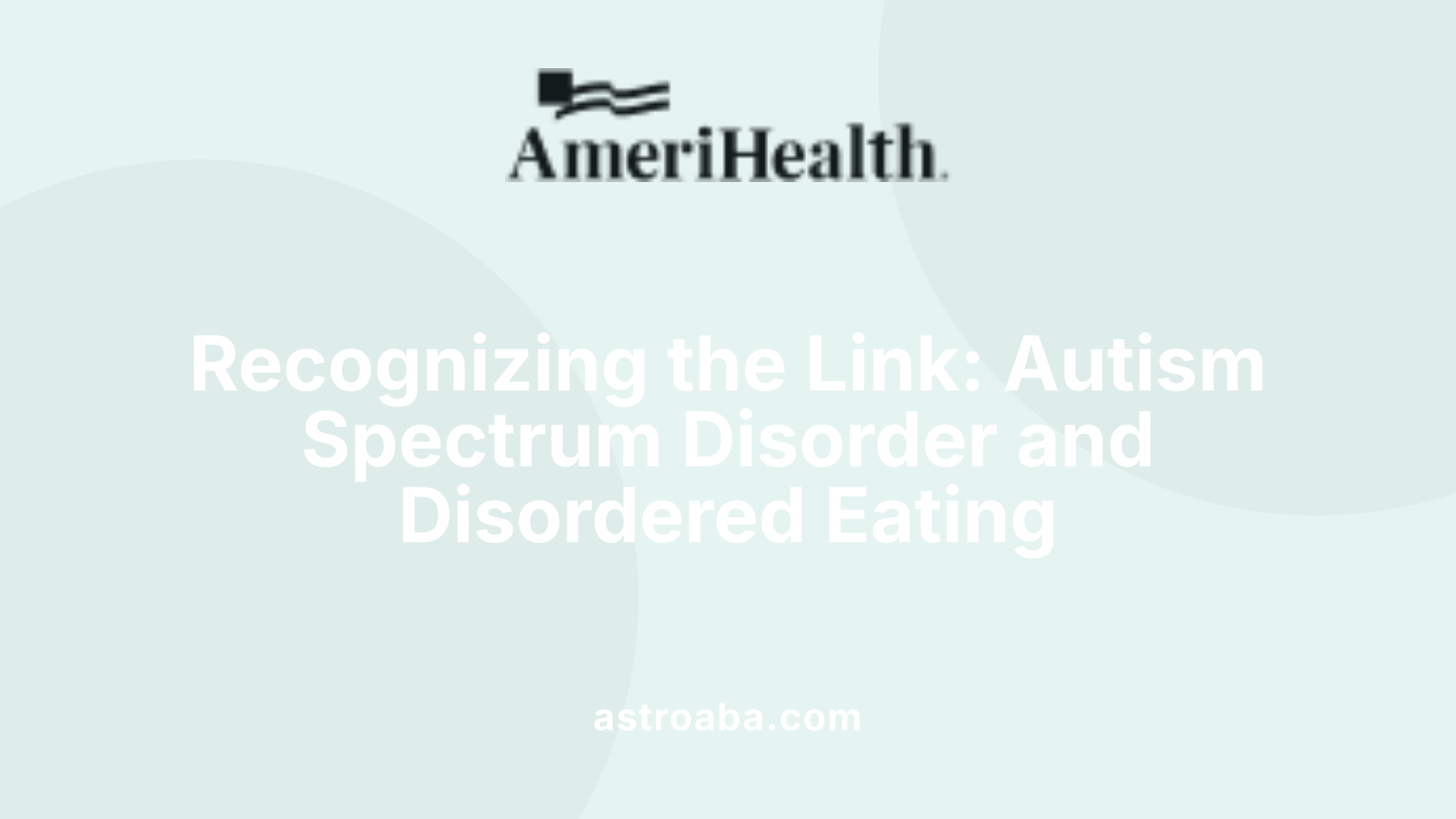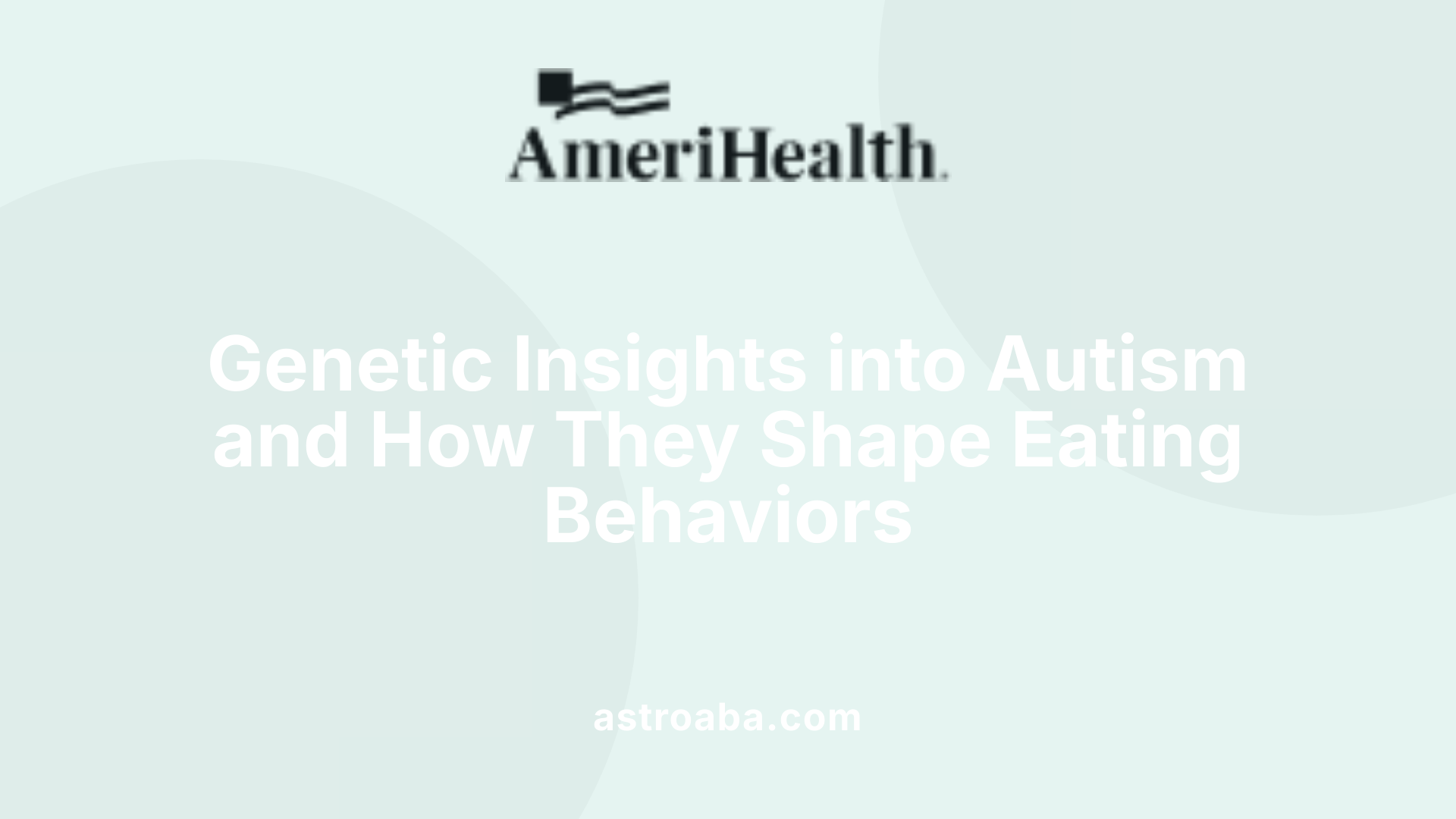Eating Disorders And Autism
Unraveling the Complex Relationship Between Autism and Eating Disorders

Understanding the Overlap and Its Implications
The intersection of autism spectrum disorder (ASD) and eating disorders presents a multifaceted challenge in clinical diagnosis, treatment, and support. Research indicates that a significant percentage of individuals with eating disorders also display autistic traits, influencing their behaviors, treatment responses, and recovery outcomes. Recognizing the unique needs of autistic populations is crucial for developing effective, personalized interventions. This article explores the relationship between autism and eating disorders, focusing on causes, symptoms, risk factors, and support strategies grounded in recent research and expert insights.
The Overlap Between Autism and Eating Disorders

What is the relationship between autism and eating disorders?
Research indicates a notable connection between autism spectrum disorder (ASD) and eating disorders. Studies suggest that between 4% and 23% of individuals with eating disorders are also autistic, signifying a significant overlap.
Autistic individuals frequently develop eating disorders due to inherent sensory sensitivities. Many have aversions to certain textures, tastes, or food types, which can lead to restrictive eating behaviors. Additionally, challenges with emotional regulation, a preference for routines, and a need for control can contribute to disordered eating.
The presentation of eating disorders in autistic people often differs from that in neurotypical individuals. For example, sensory issues and rigid behaviors might overshadow traditional concerns like body image, making diagnosis and treatment more complex.
Common eating conditions such as anorexia nervosa and avoidant/restrictive food intake disorder (ARFID) are especially prevalent among autistic populations. Sensory sensitivities, combined with obsessive routines around food and eating, frequently underpin these disorders.
Understanding this correlation is crucial for providing tailored care. Support strategies should include accessible therapies, environmental adjustments, and recognition of sensory and routine-based behaviors. Personalizing treatment can significantly improve outcomes and quality of life for autistic individuals facing eating difficulties.
How Autism Influences Eating Behaviors and Diet

What difficulties related to eating and diet do autistic individuals often experience?
Autistic individuals frequently face unique challenges when it comes to eating and diet, primarily due to sensory processing differences. These differences can cause heightened sensitivities to various food characteristics such as tastes, textures, smells, and visual appearances. As a result, many develop highly restricted diets or selective eating patterns, often favoring only certain foods or textures.
This sensory intolerance can lead to behaviors resembling disordered eating, including food avoidance, extreme pickiness, food neophobia, or even pica—an appetite for non-food items. Such behaviors are often driven by sensory sensitivities, anxiety around eating, obsessive interests, or feelings of social isolation associated with mealtimes.
In some cases, autistic individuals develop fears related to swallowing or choking, which can significantly limit their willingness to eat certain foods or take part in meals altogether. These anxieties might stem from past negative experiences or sensory overloads during eating.
The consequences of these eating challenges can include nutritional deficiencies and dental health concerns. However, many autistic people manage to maintain adequate nutrition through tailored strategies and professional support.
Supporting autistic individuals with their unique sensory and behavioral needs involves implementing sensory-friendly approaches, establishing consistent routines, and seeking guidance from healthcare professionals. Such personalized interventions can improve their eating experiences, reduce anxiety, and promote healthier, more diverse diets.
For further insights, search terms like
Genetic Foundations of Autism and Their Impact on Eating Behaviors

What is the genetic contribution to autism?
Autism spectrum disorder (ASD) has a strong genetic component, with heritability estimates generally ranging from 50% to 90%. Recent research, including a reanalysis of Swedish national data, suggests that the heritability is approximately 83-87%. This high percentage indicates that genetic factors are the primary influence in the development of autism.
Numerous genes involved in brain development, neural connectivity, and synaptic functioning have been linked to ASD. Some of these genetic variations are inherited from parents, while others occur spontaneously as new mutations, known as de novo mutations. De novo mutations are more common in the sperm of older fathers, which can increase the risk of autism in offspring.
While genetics play a dominant role, environmental factors also contribute to autism risk. These include prenatal exposures, maternal health conditions during pregnancy, and epigenetic influences that can modify gene expression without changing the DNA sequence. However, the impact of these environmental factors appears to be smaller compared to genetic influences.
Ultimately, autism results from a complex interplay between inherited genetic variations and environmental factors. The current consensus emphasizes that genetic inheritance is the most significant contributor, influencing neural development patterns that can affect behaviors, including eating behaviors often associated with autism.
How do genetics influence eating behaviors in autistic individuals?
Autistic traits, influenced heavily by genetics, can lead to specific eating behaviors such as food selectivity, sensory sensitivities, and ritualistic food-related routines. These behaviors can sometimes resemble disordered eating patterns, complicating diagnosis and treatment.
Understanding the genetic backdrop of autism helps in developing tailored interventions. It highlights the importance of considering inherent biological factors when addressing eating behaviors in autistic populations, ultimately leading to better support and outcomes.
The Psychosocial and Emotional Aspects Driving Disordered Eating in Autistic Individuals
How do emotional regulation issues and routines contribute to eating disorders in autistic people?
Autistic individuals often face significant challenges with emotional regulation. This difficulty can lead to the development of eating disorders as a way to manage overwhelming feelings or anxiety. When emotions become hard to control, some may turn to food as a soothing mechanism or a means to feel a sense of control.
The need for routine and predictability is a hallmark of autism. This preference manifests in highly structured, ritualistic eating behaviors. Rigid routines around food, such as eating the same meals daily, calorie counting, or specific presentation styles, help reduce uncertainty and emotional distress.
These behaviors are not merely habits but serve as coping strategies, offering comfort through familiarity. They can also reinforce obsessive tendencies related to food and body image.
How do obsessive interests and fixations influence eating behaviors?
Autistic individuals often develop intense interests or fixations on specific topics like nutrition, healthy eating, or body image. These obsessive interests can evolve into disordered eating patterns, especially if motivated by the desire to achieve perfection or maintain routines.
Such fixations can lead to restrictive eating practices, preoccupation with calorie intake, or compulsive exercise, which are common in disorders like anorexia.
What is the impact of social isolation and peer influence?
Social isolation can increase feelings of loneliness and alienation, which may contribute to disordered eating behaviors as a form of coping or control. Conversely, peer influence can sometimes pressure autistic individuals to conform to certain eating norms or appearance standards, further complicating their relationship with food.
The need to fit in or be accepted may lead some to adopt specific eating patterns or behaviors, sometimes worsening underlying issues.
Understanding these psychosocial factors underlines the importance of tailored therapeutic strategies. Interventions should address emotional regulation, routines, and social influences, promoting healthier ways to cope and build resilience.
**| Aspect | Influence | Support Strategies | |---------|------------|---------------------| | Emotional regulation | Challenges lead to using food for comfort | Emotional regulation therapy, mindfulness | | Routines and control | Reinforces restrictive eating behaviors | Flexible routines, cognitive-behavioral techniques | | Obsessive interests | Drive restrictive or compulsive eating | Addressing interests within treatment, reshaping focus | | Social isolation | Heightens vulnerability to disordered eating | Social skills training, peer support |
Implications for Treatment and Support Strategies

What treatment considerations and support strategies are effective for eating disorders in autistic populations?
Treating eating disorders in autistic individuals requires a thoughtful approach that acknowledges their unique sensory, emotional, and routine-based needs. Traditional therapies are often insufficient without modifications tailored to these specific challenges.
One effective strategy is creating sensory-friendly environments, which can include adjusting lighting, sounds, and textures within treatment settings to minimize sensory overload. Therapies should also recognize the importance of routines and structure, providing clear and predictable sessions to reduce anxiety and build trust.
Supporting emotional regulation is vital, considering that many autistic people face difficulties identifying and expressing emotions—a condition known as alexithymia. Incorporating techniques such as visual aids or accessible communication formats helps facilitate emotional understanding and engagement.
A neurodiversity-affirming approach is central to successful treatment. This involves validating autistic traits, rather than viewing them as merely problematic. Emphasizing strengths and supporting self-determination can lead to more positive engagement with treatment.
Adapting therapies for autistic needs
Therapies should be flexible, including modifications like pacing interventions at the individual's comfort level, addressing sensory sensitivities, and involving caregivers as key partners in the treatment process. Cognitive-behavioral therapy (CBT), for example, can be adapted with visual supports and concrete language.
Sensory, routine, and emotional considerations
Addressing sensory sensitivities is crucial, as food aversions and textures can influence eating behaviors significantly. Therapy plans may include sensory integration techniques or occupational therapy to expand food acceptance gradually.
Maintaining structured routines helps reduce chaos and provides predictability, crucial for many autistic individuals. Consistent communication and clear expectations foster trust and facilitate progress.
Multidisciplinary team approaches
A collaborative team typically involves medical doctors, psychologists, behavioral therapists, speech-language therapists, occupational therapists, and caregivers. This multidisciplinary approach ensures that all facets of the individual's needs are met—medical, psychological, sensory, and behavioral.
Regular communication among team members allows for holistic care, tailored interventions, and adjustments based on ongoing assessments.
Development of neurodiversity-affirming care
Guidelines from health authorities promote neurodiversity-affirming practices, which are designed to respect and accommodate neurodivergent traits. This includes avoiding pathologization and instead focusing on enhancing capabilities and supporting personal growth.
In conclusion, effective support for autistic individuals with eating disorders must be personalized, inclusive, and flexible, with a focus on respecting neurodiversity. Combining tailored therapies, multidisciplinary collaboration, and a supportive environment can significantly improve outcomes and facilitate recovery.
Prevalence, Diagnosis, and Clinical Challenges in Autistic Eating Disorder Patients
What is the prevalence, diagnosis, and clinical approach to comorbidity of eating disorders and autism?
Research indicates a significant overlap between autism spectrum disorder (ASD) and eating disorders, with estimates that 20-30% of individuals with eating disorders also display autistic traits or have an autism diagnosis. For example, a review of medical records of treatment-seeking young women with eating disorders found that about 10% had a pre-existing autism diagnosis. During treatment, an additional 17.5% were diagnosed with autism, and 27.5% showed clinical suspicion of autism.
This high co-occurrence highlights the importance of early and accurate diagnosis. However, diagnosing autism in individuals with eating disorders presents unique challenges. Many traits of autism—such as rigid routines, sensory sensitivities, and obsessive behaviors—can resemble or mask typical eating disorder symptoms, making it difficult to distinguish between the two.
To address these challenges, clinicians are adopting integrated assessment methods that include autism screening tools alongside standard eating disorder evaluations. These assessments help identify autism traits that might otherwise be overlooked. Recognizing autism early allows for the development of tailored treatment strategies that consider sensory needs, routines, and emotional regulation difficulties. Such personalized approaches can significantly enhance treatment efficacy and improve recovery outcomes for this population.
Addressing Health Inequalities and Future Directions
How does autism impact health inequalities related to eating disorders and what are future directions?
Autistic individuals often encounter significant disparities in health outcomes related to eating disorders. One major reason is that standard healthcare approaches frequently do not accommodate their unique sensory sensitivities, rigid routines, and emotional regulation challenges.
Many treatments may be too rigid or not sensory-friendly, leading to difficulties in engagement and less effective recovery. This can result in poorer health outcomes, such as prolonged illness, nutritional deficiencies, and increased risk of complications. These health disparities are compounded by systemic issues, including lack of awareness and insufficient training among healthcare providers.
To address these gaps, the healthcare system must adopt more inclusive, neurodiversity-affirming care models. Such models recognize and validate the individual differences in autistic patients, offering personalized and flexible interventions tailored to their sensory, emotional, and behavioral needs. This includes providing accessible information, maintaining routines that respect autistic traits, and incorporating sensory regulation techniques into treatment plans.
Future research is critical in several areas. First, understanding the complex relationship between autism traits, disordered eating behaviors, and treatment outcomes will help refine therapeutic approaches. Second, developing specific guidelines and best practices for treating eating disorders in autistic populations is essential.
Additionally, increasing awareness and education among clinicians, policymakers, and caregivers can promote equitable access to high-quality care. This involves training on autism-specific needs, reducing systemic barriers, and advocating for policies that support neurodiversity in healthcare settings.
By focusing on these areas, the healthcare system can work towards reducing inequalities, improving treatment efficacy, and ensuring better health and recovery prospects for autistic individuals facing eating disorders.
Towards More Inclusive and Effective Support
Enhancing our understanding of the complex relationship between autism and eating disorders is essential for improving diagnosis, treatment, and support services. Recognizing the unique behavioral, sensory, and emotional needs of autistic individuals can lead to more effective, personalized interventions. As research continues to evolve, amplifying awareness and developing neurodiversity-affirming approaches will be key to reducing health disparities and fostering recovery and well-being for this vulnerable population.
References
- NEDA | Eating Disorders Support, Awareness & Recovery
- Eating disorders - National Autistic Society
- Will eating disorder program help with autism-related food aversions?
- Autism diagnosis in females by eating disorder professionals - PMC
- Eating, eating disorders and autism | What is autism? - Autistica
- Why So Many People with Autism Have Eating Disorders
- Feeding and eating problems in children and adolescents with autism
- Eating Disorders and Autism: What You Need to Know
Recent articles

The Role of Prompting and Fading in ABA Therapy Programs
Enhancing Autism Interventions Through Systematic Support Reduction

The Role of ABA Therapy in Supporting Community Participation
Enhancing Lives Through Community-Focused ABA Interventions

The Role of ABA Therapy in Encouraging Initiative and Motivation
Unlocking Potential: How ABA Empowers Children to Take Initiative

How ABA Therapy Helps Children Develop Initiation and Motivation
Unlocking Potential: The Power of ABA in Fostering Child Independence

How ABA Therapy Encourages Participation in Cooperative Group Activities
Fostering Social Skills Through ABA Interventions

How ABA Therapy Supports Independent Task Initiation in Children
Empowering Children to Begin with Confidence

How ABA Therapy Helps Children Build Resilience in Challenging Situations
Building Emotional Strength Through ABA Therapy

The Impact of ABA Therapy on Reducing Anxiety in Social Settings
Transforming Social Experiences: How ABA Therapy Eases Autism-Related Anxiety

Strategies for Teaching Self-Monitoring Through ABA
Empowering Independence: Techniques to Foster Self-Monitoring with ABA

The Benefits of Combining ABA with Speech and Language Therapy
Integrating Treatment Approaches to Maximize Developmental Progress

Strategies for Teaching Cooperative Problem-Solving Through ABA
Enhancing Collaborative Skills with ABA: Proven Strategies and Techniques

How ABA Therapy Encourages Independent Participation in Daily Tasks
Empowering Autonomy: How ABA Therapy Builds Independence in Daily Life

Creating an Effective Learning Environment at Home for ABA Therapy
Building a Supportive Home Environment for ABA Success

How ABA Therapy Encourages Following Safety Rules at Home and School
Empowering Children with Autism to Follow Essential Safety Rules

How ABA Therapy Encourages Communication Using Gestures and Signs
Enhancing Social Skills with Targeted Gesture Teaching

Common ABA Therapy Techniques for Reducing Aggression
Innovative Strategies in ABA to Minimize Aggressive Behaviors

How ABA Therapy Encourages Communication Using Gestures and Signs
Unlocking the Power of Gestures and Signs in Autism Therapy

How ABA Therapy Encourages Appropriate Social Greetings
Enhancing Social Skills Through Evidence-Based Interventions

Addressing Social Anxiety Using ABA-Based Techniques
Harnessing ABA to Alleviate Social Anxiety

Famous Politicians With Autism
Celebrating Neurodiversity: Insights into Autism and Notable Figures

How ABA Therapy Can Help with Anxiety in Children with Autism
Unlocking Emotional Well-Being: The Power of ABA in Managing Autism-Related Anxiety

The Impact of ABA Therapy on School Success
Enhancing Educational Outcomes with Systematic Interventions

The Importance of Social Stories in ABA Therapy
Harnessing Social Stories to Enhance Social Skills in Autism Interventions

Mild Autism
Understanding the Nuances of Mild Autism

What Are Functional Behavior Assessments (FBA) in ABA Therapy?
Unlocking the Secrets Behind Behavior: The Power of FBAs in ABA

Early Signs Of Autism In Babies And Kids
Recognizing Early Indicators to Support Developmental Health

How to Find Funding for ABA Therapy Services
Unlocking Funding Opportunities for Autism Treatments

How to Help a Child with Autism Transition to ABA Therapy
Supporting Children Through Transition Phases in ABA Therapy

Do Autistic People Get Injured More?
Examining Injury Risks in Individuals with Autism Spectrum Disorder

How ABA Therapy Can Help with Executive Functioning Challenges
Unlocking Skills: The Impact of ABA on Executive Functioning in Autism

What is the Premack Principle in ABA Therapy?
Unlocking Motivation: The Power of the Premack Principle in ABA Therapy

Low-Functioning Autism
Understanding the Challenges and Supports for Low-Functioning Autism

Low-Functioning Autism
Understanding the Challenges and Supports for Low-Functioning Autism

How ABA Therapy Can Help with Playdates and Social Events
Unlocking Social Success: How ABA Therapy Facilitates Playdates and Community Engagement

How ABA Therapy Can Address Impulse Control Issues
Mastering Behavioral Growth: The Power of ABA in Impulse Control

Book, Movie, and TV Characters on the Autism Spectrum
Enhancing Understanding Through Fictional Portrayals

Book, Movie, and TV Characters on the Autism Spectrum
Enhancing Understanding Through Fictional Portrayals

The Role of Visual Supports in ABA Therapy
Enhancing Autism Interventions with Visual Supports

What Is Pervasive Developmental Disorder
Understanding the Spectrum of Developmental Challenges

How ABA Therapy Helps with Emotional Regulation
Empowering Emotional Resilience in Children with Autism

What is Task Analysis in ABA Therapy?
Unveiling the Foundations of Task Analysis in ABA Therapy

How ABA Therapy Can Improve Play Skills
Unlocking Growth: The Power of ABA in Enhancing Play Skills

Air Pollution and Autism
Unveiling the Environmental Impact on Developing Minds

How ABA Therapy Can Help with Bullying Prevention
Building Respect and Resilience Through ABA

How ABA Therapy Can Be Used to Teach Problem-Solving Strategies
Empowering Individuals with Autism Through Targeted Problem-Solving Skills

Can Autistic People Work?
Unlocking Potential: The Realities of Employment for Autistic Individuals

How ABA Therapy Can Help with Homework and Academics
Empowering Academic Success with ABA Therapy

Common Myths About ABA Therapy Debunked
Unmasking Autism Treatment: The Truth About ABA Therapy

Does Aluminum Cause Autism?
Unraveling the Link: Aluminum and Autism Spectrum Disorder

How ABA Therapy Can Support Emotional Expression and Understanding
Unlocking Emotional Growth in Autism Through ABA Therapy

The Role of ABA Therapy in Helping Children Learn Road Safety
Empowering Safe Journeys: How ABA Therapy Fosters Road Safety Skills in Children

The Role of Group ABA Therapy in Social Development
Enhancing Social Skills Through Collective Strategies

What Is Autistic Burnout?
Understanding the Hidden Struggle of Autistic Burnout

How Do You Get An Autistic Child To Keep Their Shoes On?
Mastering Comfort and Compliance with Shoes for Autistic Children

The Role of ABA Therapy in Addressing Food Aversions and Picky Eating
Transforming Mealtimes: How ABA Therapy Supports Children with Autism

How ABA Therapy Can Assist in Reducing Perfectionism and Anxiety
Harnessing Behavioral Science to Ease Perfectionism and Anxiety

What Is Defeat Autism Now?
Unveiling the Roots and Realities of the DAN Movement

How ABA Therapy Can Help Children Develop Conflict Resolution Skills
Building Bridges: Empowering Children with Conflict Resolution Skills through ABA

OCD vs. Autism
Unraveling the Complex Relationship Between OCD and Autism

Temper Tantrums A Sign Of Autism
Understanding the Complex Relationship Between Temper Tantrums and Autism Spectrum Disorder

How to Pass the BCBA Exam
Your Ultimate Guide to Success in the BCBA Exam

Autism and Addiction's Close Connection
Unraveling the Complex Interplay Between Autism and Substance Use

Autism Facial Expressions
Decoding Emotions: The Complex World of Facial Expressions in Autism

How ABA Therapy Can Help Reduce Anxiety Around Doctor and Dentist Visits
Transforming Medical Experiences for Children with Autism

How ABA Therapy Can Help with Navigating Social Media Responsibly
Empowering Safe Online Engagement for Children with Autism through ABA

How to Choose an Autism Charity
Navigating the Spectrum of Support: A Guide to Selecting the Right Autism Charity

What is Precision Teaching in ABA Therapy?
Harnessing Data-Driven Strategies for Skill Mastery

Autism and Obesity
Understanding the Overlap: Autism and the Rising Concern of Obesity

Individualized Education Programs (IEPs) for Autism
Supporting Success: A Comprehensive Guide to IEPs for Children with Autism

How to Integrate ABA Therapy into Everyday Routines
Transforming Daily Life with ABA Strategies

What is Shaping in ABA Therapy?
Understanding the Core of Behavior Shaping in Autism Interventions

Autism vs. ADHD
Understanding the Distinction and Overlap of Neurodevelopmental Disorders

Is RBT Certification Worth It?
Unveiling the Value of RBT Certification in the Field of ABA

How Negative Reinforcement Works in ABA Therapy
Unlocking the Power of Negative Reinforcement in Behavioral Therapy

How to Advocate for ABA Therapy Services in Schools
Navigating Advocacy for School-Based ABA Therapy

How ABA Therapy Can Address Impulsivity in Children
Transforming Child Behavior: The Power of ABA Therapy Against Impulsivity

Understanding the Different Types of ABA Therapy Programs
Exploring the Spectrum of ABA Therapy Approaches

How ABA Therapy Can Address Regression in Autism
Understanding Regressive Autism and the Role of ABA Therapy

High Functioning Autism And Anger
Understanding Emotional Challenges in High-Functioning Autism

Autism and Puberty
Understanding Puberty in Autistic Youth: Challenges and Support Strategies

Challenging Autism Behavior Problems
Navigating the Complex Landscape of Autism-Related Behavioral Challenges

How ABA Therapy Can Help with Sleep Problems
Transforming Bedtime Routines with Evidence-Based Approaches

How ABA Therapy Can Help Improve Cooperation and Compliance
Fostering Respectful Engagement: The Role of ABA in Enhancing Cooperation and Compliance

Eating Disorders And Autism
Unraveling the Complex Relationship Between Autism and Eating Disorders

How Schedules of Reinforcement Work in ABA Therapy
Mastering Reinforcement Patterns to Foster Behavior Change

How to Incorporate ABA Therapy into a Homeschooling Program
Transforming Homeschooling with Evidence-Based Strategies

What Are the Most Common Misconceptions About ABA Therapy?
Unveiling the Truth Behind ABA Therapy: Myths vs. Facts

What is Demand Fading in ABA Therapy?
Demystifying Demand Fading in ABA Therapy

What Are ABA Assessments and How Do They Work?
Understanding the Foundations of ABA Assessments

What is an AAC Device for Autism?
Unlocking Communication: The Power of AAC Devices for Autism

How ABA Therapy Can Help Children Understand and Express Emotions
Enhancing Emotional Understanding Through Evidence-Based Interventions

How To Prevent Autism
Emerging Strategies to Reduce Autism Risk in Children

How ABA Therapy Can Improve Verbal and Nonverbal Communication
Unlocking Communication: The Power of ABA Therapy for Children with Autism

Natural Environment Teaching (NET): How It Helps with Skill Generalization
Unlocking Practical Learning in Natural Settings

What Is Play Therapy For Autism?
Unlocking the Potential of Play in Autism Therapy

How ABA Therapy Can Improve Fine and Gross Motor Skills
Enhancing Movement and Independence Through ABA Strategies

Calming Strategies For Kids With Autism
Understanding and Supporting Calmness in Children with Autism

Autism Evaluation
Comprehensive Insights into Autism Assessment and Diagnosis

How to Support Your Child's ABA Therapy at Home
Empowering Your Child’s Development at Home with ABA Support

Autism Prevalence Increases in Arizona
Rising Autism Rates Signal Changing Landscape in Arizona

